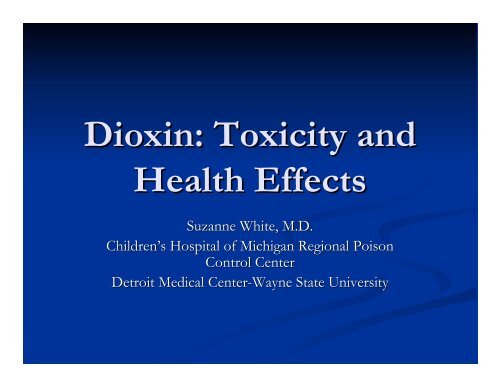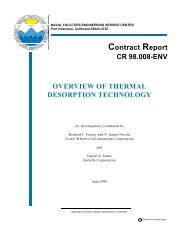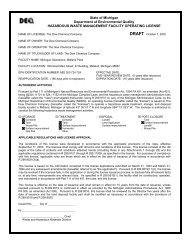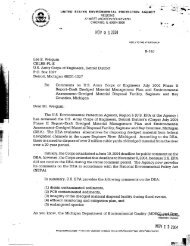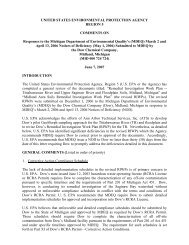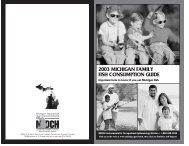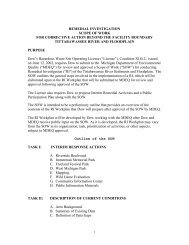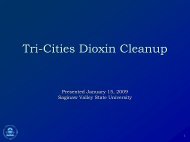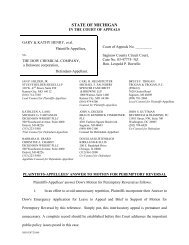Dioxin: Toxicity and Health Effects - State of Michigan
Dioxin: Toxicity and Health Effects - State of Michigan
Dioxin: Toxicity and Health Effects - State of Michigan
You also want an ePaper? Increase the reach of your titles
YUMPU automatically turns print PDFs into web optimized ePapers that Google loves.
<strong>Dioxin</strong>: <strong>Toxicity</strong> <strong>and</strong><br />
<strong>Health</strong> <strong>Effects</strong><br />
Suzanne White, M.D.<br />
Children’s s Hospital <strong>of</strong> <strong>Michigan</strong> Regional Poison<br />
Control Center<br />
Detroit Medical Center-Wayne <strong>State</strong> University
What is <strong>Dioxin</strong><br />
• Chlorinated dibenzo-p-<br />
dioxins= = a family <strong>of</strong> 75<br />
chemicals<br />
• Colorless, odorless solids<br />
• Prototype is 2,3,7,8-<br />
TCDD (most toxic)<br />
• Exist as mixtures (TEQ)<br />
• Not intentionally<br />
manufactured
Sources<br />
• Chlorine bleaching processes at pulp <strong>and</strong> paper<br />
mills<br />
• Waste & drinking water treatment<br />
• Chemical manufacturing contaminants<br />
• Released into air in emissions<br />
• Uncontrolled combustion <strong>of</strong> household wastes
Fate <strong>of</strong> CDDs<br />
• Persistent<br />
• Emissions: may be transported in air long<br />
distances<br />
• Waste water: most attaches to soil- sediment<br />
• Concentrate in food chain<br />
• Overall environmental levels declining in US
Human Exposure<br />
• 95% diet (meat, dairy,<br />
fish, breast milk)<br />
• Proximity to hazardous<br />
waste site or incinerator<br />
• Air, water, skin contact:<br />
less significant<br />
• Occupational<br />
• Half-life life ~ 8.5 years
<strong>Dioxin</strong> <strong>Toxicity</strong><br />
• Potent animal toxicants<br />
• Tremendous species variability<br />
• <strong>Dioxin</strong>s have a common toxic mechanism<br />
• Alter basic steps for cell growth <strong>and</strong> development<br />
• Results in broad impact in animals:<br />
• Reproductive/developmental<br />
• Immunologic<br />
• Skin<br />
• Cancer
Gary Perdew www.cas<br />
cas.psu.edu/docs/CASDEPT/VET/<br />
/docs/CASDEPT/VET/ppl/perdew/pages/ah_rec.html
Human <strong>Toxicity</strong><br />
• Occupational studies<br />
(chemical workers)<br />
• Accidents<br />
Missouri, Italy, Asia<br />
• Breast milk<br />
• Netherl<strong>and</strong>s<br />
• Vietnam veterans
Human Cancer<br />
• <strong>Dioxin</strong> is a human carcinogen<br />
• Exposure to TCDD increases the risk <strong>of</strong> cancer<br />
at multiple sites, including lung CA<br />
• Overall increased risk in occupational/accident<br />
studies is 40-100%<br />
• Possible association with STS<br />
• Little if any association with NHL or skin CA
Human Non-cancer <strong>Effects</strong><br />
• Good evidence<br />
• Chloracne<br />
• Acute high level or chronic<br />
• Persists 10 years<br />
• Liver enzyme changes<br />
• No evidence for disease<br />
• Higher in drinkers<br />
• Reproductive hormone<br />
changes<br />
• Decreased testosterone<br />
• Decreased libido
Human Non-cancer <strong>Effects</strong><br />
• Possible effects<br />
• Blood lipids: ↑ TG/cholesterol<br />
• Diabetes<br />
• Post-natal development<br />
• Neurobehavioral<br />
• Thyroid<br />
• Liver enzymes<br />
• Platelets
Human Non-cancer <strong>Effects</strong><br />
• Good evidence in animals, but human data<br />
inconclusive<br />
• Circulatory<br />
• Immunologic<br />
• No change in children <strong>of</strong> Seveso at 2 years<br />
• Limited data on depressed T-cell T<br />
function<br />
• Semen changes<br />
• Endometriosis
Human Non-cancer <strong>Effects</strong><br />
• Emerging Issues: further study needed<br />
• Miscarriage rate<br />
• Birth defects<br />
• Majority studied are paternal exposures<br />
• Misclassification may have occurred<br />
• Dental effects<br />
• Sex ratio<br />
• Growth measures<br />
• Decreased length (transient) & birth weight<br />
• Increased preterm birth & neonatal death rate
Human Non-cancer <strong>Effects</strong><br />
• Lack <strong>of</strong> evidence for:<br />
• Long-term thyroid gl<strong>and</strong> effect<br />
• Renal effect<br />
• Pulmonary effect<br />
• Adult neurologic effect
General Population Body Burden<br />
• Estimated to be 25 ppt (pg TEQ/g lipid)<br />
• Approaches the levels at which adverse events<br />
are expected<br />
• No clear indication <strong>of</strong> disease<br />
• Scientific limitations<br />
• Increased risk <strong>of</strong> cancer may be 1: 1,000<br />
increased chance
Special Populations<br />
• Children may be at greater risk for illness related<br />
to environmental contaminants<br />
• Increased outdoor play<br />
• Increased h<strong>and</strong>-to<br />
to-mouth activities<br />
• Shorter stature- dust, soil, vapors<br />
• Higher intake rate, lower body weight = greater dose<br />
• Critical, rapid growth stages<br />
• Latency
Midl<strong>and</strong><br />
• <strong>Michigan</strong> vital statistics & MRCIF<br />
• No persistently elevated numbers <strong>of</strong> specific cancer<br />
types<br />
• Higher than expected numbers <strong>of</strong> all cancers<br />
combined for zip code 48640
Midl<strong>and</strong><br />
• MBDR<br />
• No increased anencephaly, spina bifida, cleft lip in<br />
Midl<strong>and</strong> County<br />
• Limitations
Special Populations<br />
• Fetuses, infants <strong>and</strong> children may be more<br />
susceptible based on rapid growth &<br />
development<br />
• Unknown whether children in the general<br />
population are experiencing health effects from<br />
dioxin<br />
• Immunocompromised
Prevention<br />
• Avoid contact with soils near contaminated or<br />
hazardous waste sites<br />
• Discourage children from eating dirt/putting toys in<br />
their mouth, h<strong>and</strong> hygiene<br />
• Diet<br />
• Fish advisory<br />
• Avoid food sources from contaminated areas<br />
• Wash & peel fruits & vegetables from contaminated areas<br />
• Smoking/alcohol<br />
• Recreation<br />
• Do not stop breast feeding


